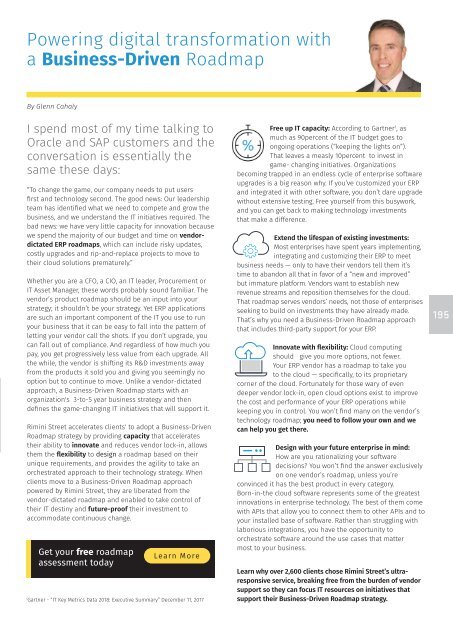Business Chief April 2019
You also want an ePaper? Increase the reach of your titles
YUMPU automatically turns print PDFs into web optimized ePapers that Google loves.
Powering digital transformation with<br />
a <strong>Business</strong>-Driven Roadmap<br />
By Glenn Cahaly<br />
I spend most of my time talking to<br />
Oracle and SAP customers and the<br />
conversation is essentially the<br />
same these days:<br />
“To change the game, our company needs to put users<br />
first and technology second. The good news: Our leadership<br />
team has identified what we need to compete and grow the<br />
business, and we understand the IT initiatives required. The<br />
bad news: we have very little capacity for innovation because<br />
we spend the majority of our budget and time on vendordictated<br />
ERP roadmaps, which can include risky updates,<br />
costly upgrades and rip-and-replace projects to move to<br />
their cloud solutions prematurely.”<br />
Whether you are a CFO, a CIO, an IT leader, Procurement or<br />
IT Asset Manager, these words probably sound familiar. The<br />
vendor’s product roadmap should be an input into your<br />
strategy; it shouldn’t be your strategy. Yet ERP applications<br />
are such an important component of the IT you use to run<br />
your business that it can be easy to fall into the pattern of<br />
letting your vendor call the shots. If you don’t upgrade, you<br />
can fall out of compliance. And regardless of how much you<br />
pay, you get progressively less value from each upgrade. All<br />
the while, the vendor is shifting its R&D investments away<br />
from the products it sold you and giving you seemingly no<br />
option but to continue to move. Unlike a vendor-dictated<br />
approach, a <strong>Business</strong>-Driven Roadmap starts with an<br />
organization's 3-to-5 year business strategy and then<br />
defines the game-changing IT initiatives that will support it.<br />
Rimini Street accelerates clients' to adopt a <strong>Business</strong>-Driven<br />
Roadmap strategy by providing capacity that accelerates<br />
their ability to innovate and reduces vendor lock-in, allows<br />
them the flexibility to design a roadmap based on their<br />
unique requirements, and provides the agility to take an<br />
orchestrated approach to their technology strategy. When<br />
clients move to a <strong>Business</strong>-Driven Roadmap approach<br />
powered by Rimini Street, they are liberated from the<br />
vendor-dictated roadmap and enabled to take control of<br />
their IT destiny and future-proof their investment to<br />
accommodate continuous change.<br />
Get your free roadmap<br />
assessment today<br />
Learn More<br />
1<br />
Gartner - “IT Key Metrics Data 2018: Executive Summary” December 11, 2017<br />
Free up IT capacity: According to Gartner 1 , as<br />
much as 90percent of the IT budget goes to<br />
ongoing operations (“keeping the lights on”).<br />
That leaves a measly 10percent to invest in<br />
game- changing initiatives. Organizations<br />
becoming trapped in an endless cycle of enterprise software<br />
upgrades is a big reason why. If you’ve customized your ERP<br />
and integrated it with other software, you don’t dare upgrade<br />
without extensive testing. Free yourself from this busywork,<br />
and you can get back to making technology investments<br />
that make a difference.<br />
Extend the lifespan of existing investments:<br />
Most enterprises have spent years implementing,<br />
integrating and customizing their ERP to meet<br />
business needs — only to have their vendors tell them it’s<br />
time to abandon all that in favor of a “new and improved”<br />
but immature platform. Vendors want to establish new<br />
revenue streams and reposition themselves for the cloud.<br />
That roadmap serves vendors’ needs, not those of enterprises<br />
seeking to build on investments they have already made.<br />
That’s why you need a <strong>Business</strong>-Driven Roadmap approach<br />
that includes third-party support for your ERP.<br />
Innovate with flexibility: Cloud computing<br />
should give you more options, not fewer.<br />
Your ERP vendor has a roadmap to take you<br />
to the cloud — specifically, to its proprietary<br />
corner of the cloud. Fortunately for those wary of even<br />
deeper vendor lock-in, open cloud options exist to improve<br />
the cost and performance of your ERP operations while<br />
keeping you in control. You won’t find many on the vendor’s<br />
technology roadmap; you need to follow your own and we<br />
can help you get there.<br />
Design with your future enterprise in mind:<br />
How are you rationalizing your software<br />
decisions? You won’t find the answer exclusively<br />
on one vendor’s roadmap, unless you’re<br />
convinced it has the best product in every category.<br />
Born-in-the cloud software represents some of the greatest<br />
innovations in enterprise technology. The best of them come<br />
with APIs that allow you to connect them to other APIs and to<br />
your installed base of software. Rather than struggling with<br />
laborious integrations, you have the opportunity to<br />
orchestrate software around the use cases that matter<br />
most to your business.<br />
Learn why over 2,600 clients chose Rimini Street’s ultraresponsive<br />
service, breaking free from the burden of vendor<br />
support so they can focus IT resources on initiatives that<br />
support their <strong>Business</strong>-Driven Roadmap strategy.<br />
195

















